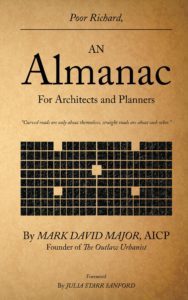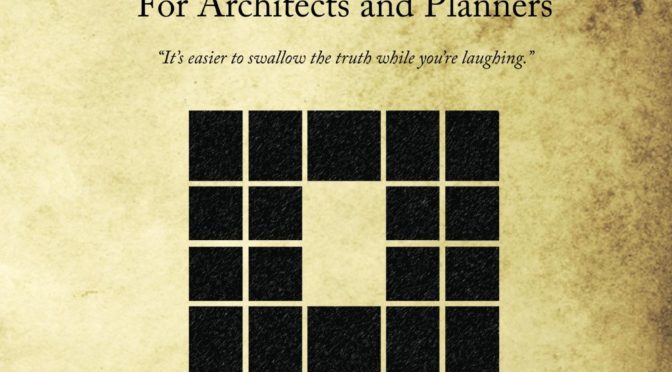 Planning Naked | April 2017
Planning Naked | April 2017
Special Issue on Transportation
by Dr. Mark David Major, AICP, CNU-A
The previous issue of Planning Magazine (March 2017) gave me an excruciating, migraine headache and I definitely lost my temper while writing Planning Naked. I watched about one year’s worth of slow but steady progress in the editorial/word choices of the American Planning Association go out the window in a hysterical, reactionary response to the election of President Donald Trump; assuming these Planning Magazine articles are queued out a couple of months in advance. The fault is not Trump’s but the ‘establishment’ using any excuse (however, flimsy) to assert the dominant planning paradigm of the status quo for the last 70 years, which can be simply summarized as ‘Cars, Money, and Bureaucracy.’ I don’t have much hope for this April 2017 Special Issue on Transportation doing much to alleviate my professional concerns since the special issue on this very topic two years ago was an unmitigated disaster; especially the cover of vehicular road signs, which still irritates me. Let us see what this issue has in store for us…
A car is still a car. On the cover is the “front of a Waymo driverless car at a Google event last December in San Francisco (see pp. 5). So yeah, ‘transportation is cars’ is once again the front and center visual for APA’s Planning Magazine special issue on transportation. I can hear their objections to this observation, “But, but, but, but we have articles about bike-sharing and mention pedestrians and walking and rail and nature.” Yes, you do but the graphics and digging into the substance of the content only illustrates how APA ‘talks the talk’, ‘drives the drive’, and even ‘drives the talk’ but refuses to ever ‘walk the talk’ when the rubber meets the road. OK, there are a LOT of mixed metaphors about lip service in there but you know what I mean.
Ditch the word transportation. Maybe Planning Magazine could start with something simple like changing the title of this annual issue to “Special Issue on Mobility” or “…on Movement”? Just a thought…
Oh, chase the shiny object. “The Road Less Traveled” by James M. Drinan, JD (From the Desk of APA’s Executive Officer, pp. 7) sets the tone for APA as a professional organization chasing the ‘next shiny object’ that just so happens to pass across its field of vision. The advertisement photographs of planners playing in the exhibit’s area of national planning conference (prior on pp. 2-3) only reinforces the idea: Computers! Pinball machines! Free promotional pamphlets! Up, close, and personal with a drone! Virtual reality! Projector graphics and ice cream scoops?!? (Not sure about that last one) In any case, for this issue, it means new “disruptive transportation technologies” and “calls for infrastructure investment” (translation: there is “bipartisan support” to give us money), which can be linked to “economic development principles (jobs!).” Ahem, how about better understanding the road most travel by most people first? All of the evidence suggests APA is still clueless about that.
Cars, money, and bureaucracy. All-inclusive including the inside/outside of the front and back covers, this issue is 56 pages long. About 65% is really about cars, money, and protecting/promoting the bureaucracy/regulatory regime of planners. The issue pays lip service to other issues but…
 Good News! You can be an Outlaw, too. The “New Hampshire Greenlights Granny Flats Statewide” article by Madeline Bodin (News Section, pp. 13) is great news! However, it is extremely disturbing that “the New Hampshire planning community was mixed on [the law].” Of course, the planners and municipalities initially opposing the law introduced a condition requiring that granny flats be ‘owner-occupied’, which is an insidious attempt to limit affordable, rental housing for lower income and young people. The Outlaw Urbanist would like to encourage all New Hampshire homeowners to violate this law immediately and continually since the ‘owner-occupied’ provision is essentially unenforceable. We are all outlaws now! “Lord I never drew first, But I drew first blood, I’m no one’s son, Call me young gun…”
Good News! You can be an Outlaw, too. The “New Hampshire Greenlights Granny Flats Statewide” article by Madeline Bodin (News Section, pp. 13) is great news! However, it is extremely disturbing that “the New Hampshire planning community was mixed on [the law].” Of course, the planners and municipalities initially opposing the law introduced a condition requiring that granny flats be ‘owner-occupied’, which is an insidious attempt to limit affordable, rental housing for lower income and young people. The Outlaw Urbanist would like to encourage all New Hampshire homeowners to violate this law immediately and continually since the ‘owner-occupied’ provision is essentially unenforceable. We are all outlaws now! “Lord I never drew first, But I drew first blood, I’m no one’s son, Call me young gun…”
So that happened… The “Zoning and ADA Compliance” article by Robin Paul Malloy (Legal Lessons on pp. 14) is an inoffensive reminder for people who might fall short in common sense, basic decency, and good manners.
I’ll pass, thanks. “Here Come the Robot Cars” by Tim Chapin, Lindsay Stevens, and Jeremy Crute (pp. 15-21). Full disclosure: I have known Lindsay Stevens since 2003. She is a friend. I have also met Tim Chapin, who invited me to guest lecture at Florida State University in Fall 2008. I don’t know Jeremy Crute. Out of respect for Lindsay, I am not going to comment on this article about autonomous vehicles (i.e. driverless vehicles) based on a study conducted on behalf of the Florida Department of Transportation.
I love the smell of sarcasm in the morning. Q&A section about “Disruption: Bike-Share” (pp. 24-25) in which Planning Magazine’s Editor-in-Chief, Meghan Stromberg interviews Jon Terbush of Zagster, a venture-funded startup company based in Cambridge, Massachusetts that designs, builds, and operates bike-sharing programs. I absolutely LOVE Terbush’s response to Stromberg’s question, “What are the minimum requirements for bike share?” Terbush responds, “Well, I’d still say the vision is the most important thing.” You can feel Terbush’s sarcasm dripping off the page after receiving such a backward ‘trapped-in-the-box’ type of question. Well done, Mr. Terbush. You smacked down APA and Planning Magazine even if they seemed blissfully unaware of it.
You can do those things that are ‘generic’ to all cities. The Q&A section “Disruption: Ride Share” (pp. 26-27) is a straightforward discussion about profiteering on the share services associated with the automobile… as if ‘unlicensed taxi services’ haven’t been around for decades (such as in London). That is essentially what companies such as Uber and Lyft are, i.e. they are circumventing government regulations (nay, restrictions) on labor in the same way zoning out granny flats restricts affordable housing and owners’ ability to profit on their property without the blessings of government. In any case, Andrew Salzberg’s closing comment is great advice, namely to “focus on things that are eternally true.” Well said, sir.
Oh, parking, you’re so fine, parking’s so fine, it blows my mind! Oh, parking! Ahem, four pages about parking with all sorts of buzzwords designed to promulgate the status quo. “Parking is an asset for cities,” “It plays a vital role (in making money, I translated the ‘code’ for you here but the “Driven by Technology” insert makes it clear),” it is “an important planning resource,” and so on and so forth. I was especially amazed to read how parking is “helping to reduce roadway congestion.” Along the way, the editors implicitly promote the decades-long myth of every Main Street shop owner, namely ‘Main Street would survive if we only had more parking.’ Planning Magazine does not say that, of course, but instead tells us people “will avoid public parking” if you charge too much for it. They do not mean people might walk or use a bike. The little 1” x 3.5” insert for The High Cost of Free Parking by Donald Shoup within the context of this article is quaint. See: equal time (<sarcasm).
Insidiously lies the crown. At first glance, “Connecting the Dots” by Greg Griffin (pp. 32-39) seems like it is promoting the bike share concept. However, by tying bike sharing to inequity issues it is actually undercutting it. This is ironic considering the equity and standard of living impacts of not owning a car are much, much worse and pervasive in American society. This article is insidious because the key underlying issue is American settlements have been building large rectangular blocks, expanded road widths, and consuming land for centuries, which the automobile has only accentuated over the last century or so. It is the spread-out physical nature of the American settlement itself, which generates many of these inequity issues. However, by ignoring the real issue (planning and land consumption), Planning Magazine can use the inequity issue to undercut the bike share concept. Not overtly, you understand, but by throwing up ‘cautionary’ impediments along the way in the regulatory regime.
See: APA mentioned rail. Planning Magazine pauses in “Rail Relationship” by Raymond Besho (pp. 40-42) to remind us that freight rail traffic is worth a lot of money, too. They then prescribe solutions to promote rail freight at the expense of livability for human beings in settlements; all in the name of “safety.” Trains killed 265 people in 2016 (Source: Federal Railroad Administration). Wow, it is an epidemic! Automobiles kill more than 30,000 people each year. Perspective, people.
In closing. I want to close out this version of Planning Naked by repeating the opening line of the “Cultivating Stronger Connections with the Natural World” article by Timothy Beatley (pp. 49-50):
“Too often nature seems abstract and far away, difficult to know and touch in any visceral way.”
I would like you to think about that statement. I mean, I want you to think really hard about the opening line of this article in a national magazine of a national organization dedicated to the ‘art and science of designing cities.’ I hope you do not laugh too hard when you realize the statement is patently absurd.
At least, this time I kept my temper and I did not get a headache. This represents progress of a certain kind, I suppose.
Planning Naked is an article with observations and comments about a recent issue of Planning: The Magazine of the American Planning Association.



 Planning Naked | March 2017
Planning Naked | March 2017 Strike that. Reverse It. Welcome, Florida Lawyers Bearing Gifts. However, having said that, the more advanced state of staff reports in Florida – due to their quasi-judicial nature associated with the 1985 Growth Management Act and subsequently, Mr. Barnebey’s greater experience with the best of such staff reports – starkly contrasts with the next article, “The Better STAFF REPORT” by Bonnie J. Johnson (pp. 20-24). Allow me to state more simply the point that I believe Dr. Johnson is attempting to convey: the best staff reports combine: 1) well-written content with 2) well-designed visuals and 3) promptly get to the point. Like most planners, Dr. Johnson’s article manages to fail on all these counts. Johnson does not even seem to know her audience for this article (i.e. there are lots of different types of planners and staff reports) so she makes the mistake of trying to address ALL possible audiences. The result is inadequate for everyone. The graphic design of this article makes the content even more confusing. I mean it is really, really bad but hardly surprising. In my experience, most planners are woefully under-trained in the art of graphic design. I do not know if this is the fault of Dr. Johnson or Planning Magazine but, seriously, reading this article gave me a fucking headache.
Strike that. Reverse It. Welcome, Florida Lawyers Bearing Gifts. However, having said that, the more advanced state of staff reports in Florida – due to their quasi-judicial nature associated with the 1985 Growth Management Act and subsequently, Mr. Barnebey’s greater experience with the best of such staff reports – starkly contrasts with the next article, “The Better STAFF REPORT” by Bonnie J. Johnson (pp. 20-24). Allow me to state more simply the point that I believe Dr. Johnson is attempting to convey: the best staff reports combine: 1) well-written content with 2) well-designed visuals and 3) promptly get to the point. Like most planners, Dr. Johnson’s article manages to fail on all these counts. Johnson does not even seem to know her audience for this article (i.e. there are lots of different types of planners and staff reports) so she makes the mistake of trying to address ALL possible audiences. The result is inadequate for everyone. The graphic design of this article makes the content even more confusing. I mean it is really, really bad but hardly surprising. In my experience, most planners are woefully under-trained in the art of graphic design. I do not know if this is the fault of Dr. Johnson or Planning Magazine but, seriously, reading this article gave me a fucking headache.





